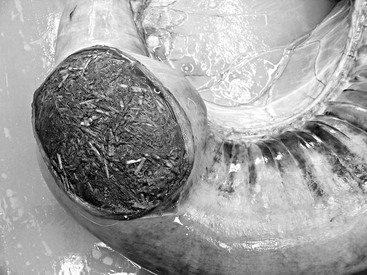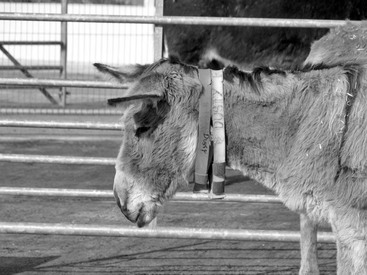Nicole du Toit, Faith Burden
Donkey Colic
As is true in horses, there are many causes of abdominal pain in donkeys, most of which are gastrointestinal in origin. These can be classified into dietary motility disorders, displacements, infections (bacteria, protozoa, endoparasites), and inflammation, including ulceration. There are, however, physiologic and behavioral differences between donkeys and horses that influence the presenting signs in donkeys such that they are not as characteristic or prominent as in horses. Spasmodic colic is the most common type of colic seen in horses in first-opinion practice, but this type of colic is seen in only a small percentage of donkeys with colic. This difference may be related to the differences in donkey behavior in not exhibiting overt clinical signs and the usual short duration of spasmodic colic. In contrast, impaction colic is regarded as the most common type of colic seen in donkeys. Other common gastrointestinal causes of colic seen in donkeys include colon displacement, intestinal torsion, and colitis.
Clinical Signs
Pain-related clinical signs in donkeys are much more subtle than those observed in horses. Because donkeys are sedentary by nature, it may be difficult to identify sick donkeys unless their normal behavior is understood. It is believed that donkeys frequently exhibit anhedonia (absence of behavior) rather than unique pain-response behaviors. Subtle changes in behavior, such as lowered head carriage, reduced ear movements (Figure 76-1), reduced social interaction, inappetence, and reduced response to stimuli may be the only indication of colic. Also, sick donkeys often exhibit sham eating, wherein they stand near the feed trough and prehend the occasional mouthful of food but do not swallow or truly eat. This may give the false impression that anorexic donkeys are still eating and cause further delays in requesting veterinary assistance. Because of their subtle clinical signs, all sick donkeys should be regarded as clinical emergencies, with the disease process likely being of longer duration than reported. In cases of acute abdominal pain such as gastrointestinal torsion, donkeys may exhibit overt colic signs such as flank watching, kicking, sweating, and rolling.
Clinical Examination
Clinical examination of a donkey may be useful in determining the cause and severity of colic. Donkeys may have tachycardia (heart rate > 44 bpm) with colic, but in some instances, such as with impaction colic, the tachycardia may be relatively mild (44 to 60 bpm). Donkeys with other causes of colic may have severe tachycardia (>80 bpm). Heart rate is affected by pain, but also by hemoconcentration, hydration status, and endotoxemia, which collectively usually result in a greater increase in heart rate. Donkeys have a more marked physiologic response to dehydration, compared with horses. As with horses, the donkey hindgut acts as a reservoir for water, so that reduced fecal dry weight and fecal water loss occur during times of water restriction. Donkeys also can maintain plasma volume even when they are as much as 20% dehydrated, so they are often more than 10% dehydrated before clinical signs associated with dehydration become apparent.
Assessment of the mucous membranes is useful in determining the severity of colic. Healthy donkeys normally have pale pink mucous membranes and are less likely to show the yellow discoloration characteristically seen in horses that are inappetent or anorexic. Dry mucous membranes with prolongation of capillary refill time (normal, <2 seconds) are a good indicator of moderate to severe dehydration. In donkeys with endotoxemia, the mucous membranes, like those of horses, may become dark red or purple tinged with red. Higher-than-normal rectal temperature is most likely to be observed in donkeys with endotoxemia, such as occurs with gastrointestinal torsion or colitis.
Mild tachypnea (respiratory rate > 20 bpm) may be observed with colic, but this is more likely to be marked in donkeys with respiratory disease. However, donkeys with intestinal displacement or visceral enlargement that is causing pressure on the diaphragm may present with severe tachypnea.
Abdominal auscultation will identify an increase or decrease in the frequency of borborygmus. Colic caused by impaction, large colon displacement, or torsion is more likely to be accompanied by reduced gut sounds.
Ancillary Diagnostic Aids
Rectal palpation is an important diagnostic tool in evaluating a sick donkey. It is possible to perform a safe rectal examination on very small donkeys, but the procedure should be undertaken with good restraint (with or without sedation) and copious lubrication. In cases of large intestinal torsion with colon distension, it may be difficult to gain access to the abdominal cavity because of the small size of the donkey and the distended intestines. Impactions may be more difficult to detect on rectal examinations in donkeys than in horses. The pelvic flexure is the most common site for intestinal impactions in donkeys but, unlike in horses in which pelvic flexure impactions are palpable as a large doughy mass in the pelvic canal, in donkeys impactions are usually small, very hard, and oval-shaped (Figure 76-2). These often displace cranially or ventrally into the abdominal cavity and can be mistaken for primary colon displacements. The presence of dry, mucus-covered fecal balls within the rectum should alert the practitioner to the likelihood of hyperlipemia. Hyperlipemia can be a primary disease or can develop secondary to other diseases, such as colic. Therefore rectal examination should still proceed if hyperlipemia is suspected.

< div class='tao-gold-member'>
Stay updated, free articles. Join our Telegram channel

Full access? Get Clinical Tree



